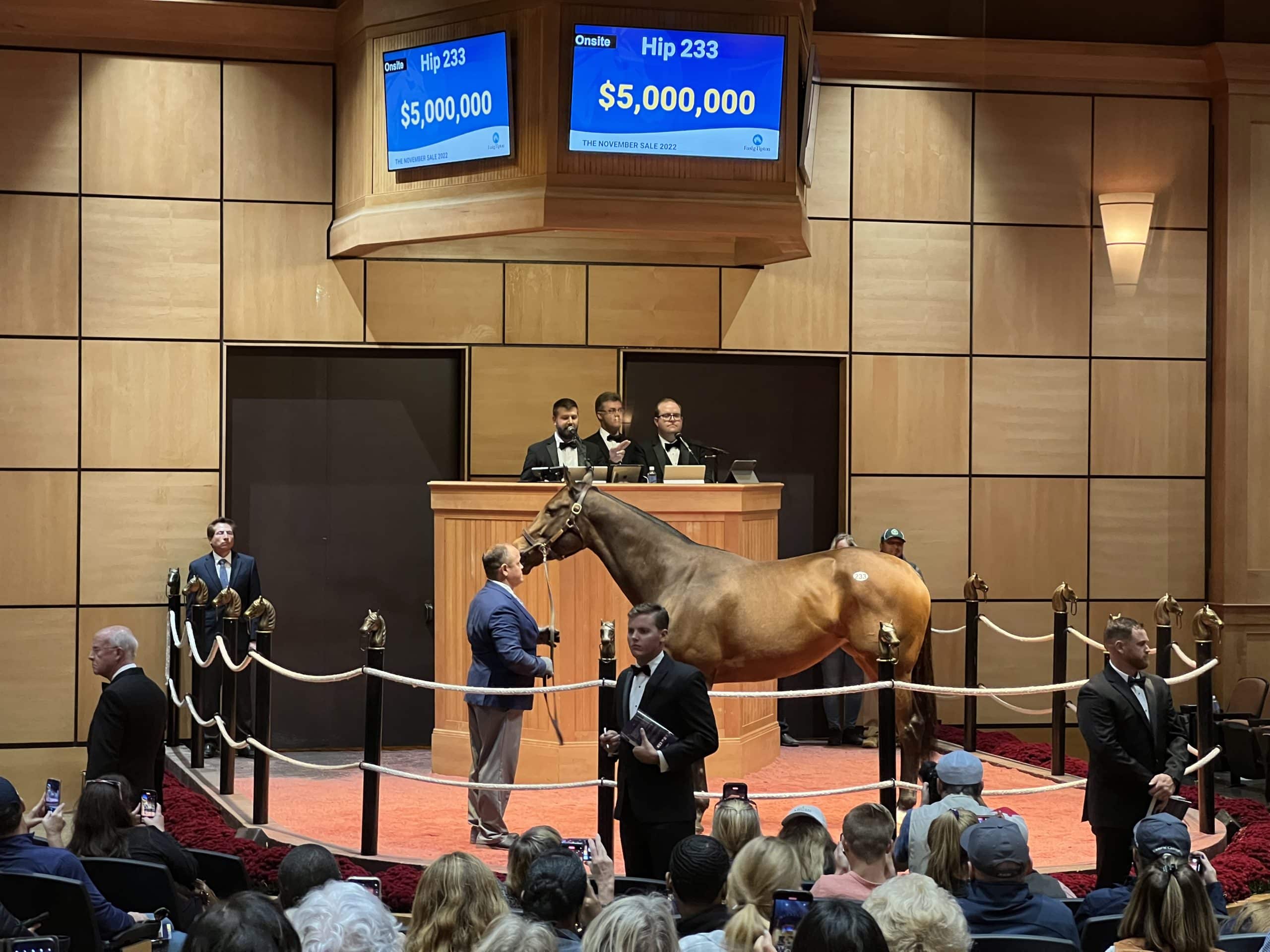
This particular horse might be out of the price range for a sport buyer, but there are plenty of gems to be found at Thoroughbred sales. Photo by Kristen Bentley
At first glance a Thoroughbred horse sale looks like chaos. Someone is making what sounds like unintelligible noises from the auction stand, while several others stand in front, gesturing wildly. People are milling about everywhere, and horses are heading in and out of the ring faster than a rider gets excused following multiple refusals at the first jump.
But despite the seeming dis-organization, a tremendous amount of work and planning goes into a successful Thoroughbred sale. Ideally, those efforts result in happiness on the part of buyers and sellers as horses head to new careers, whether on the racetrack, in the breeding shed or in some other discipline.
As someone who’s more familiar with riding than racing circles, how do you go about wading into this busy scenario? A few preparations can help you navigate any Thoroughbred sale. You can elect to go it alone, or you can hire an agent to help you through the process.
If you can, attend a sale before you decide to go to buy a horse at one. Watching the activity and following along in the catalog can get you comfortable with the process, as well as with the cadence of the sale and the auctioneering action.
Don’t worry if you can’t understand what the auctioneer is saying. The chant is designed to create a sense of urgency in the selling, and you can check the TV monitors to see exactly how much money is being bid. An auctioneer might be saying “one, give me two” and mean $1,000, $100,000 or $1 million.
As each horse is led into the ring, an announcer beside the auctioneer in the stand will give a short spiel about the animal. Savvy buyers will have already done their homework and know what is good and bad about the horse. Still, it pays to listen because, depending on the type of sale, the announcer might be required to reveal certain information from the stand, such as that the horse is a cribber.
Gayle Van Leer is a bloodstock agent based in Southern California who for years has helped people buy horses throughout the U.S. in every price range. She shares some of her tips for having a successful experience at horse sales.
“I talk to clients about everything from what kind of shoes and jackets to wear to the pace of the sale and when you can expect to eat lunch,” Van Leer says.
An agent, who usually charges a standard fee of 5% of the final price of the horse, can save you time and money. Van Leer learns what type of horses and price range a person is looking for and then tailors her recommendations to suit.
“You’ll miss horses that are of good value that are in your price range without help,” she says. “I cannot emphasize enough how fast the pace is. You’re going to miss a lot of buying opportunities.”
You or your agent must do some homework, which begins when the catalog comes out. You can usually pick one up at the sales office, but the quickest way is to find it online. Many are available through the Equineline Sales Catalog iPad app. It is free and includes indexes and many other time-saving features.
Catalog pages provide information about the horse’s pedigree — sire, dam and other close relatives. Reading a catalog page can be an art form, but the basics most buyers look for are black type. Horses with their names in boldface all-capital letters have won a stakes race, one of the highest-quality races available. If the name is in boldface and not all caps, the horse has placed, meaning finished second or third, in a stakes.
Usually, the catalog will include the race names in which the horse won or placed. Stakes are further categorized by quality, with Grade 1 being the best. You can see the amount of money a horse earned during his racing career and, if it doesn’t have black type, whether he won or placed in other types of races, was unraced, etc.
People looking for racing prospects generally want as much black type as possible. Van Leer suggests someone looking for a horse for a different purpose might find bargains by avoiding black type.
“The more black type, the more the horse is going to cost,” she says. “Try to find horses with the least amount of black type on their catalog page because those might be more in your price range.”
Of course, you need to couple that with your assessment of the horse in other areas. For example, Van Leer has a good knowledge of what horses by certain stallions will look like. She knows some stallions tend to get big, good-looking horses that do well in the show ring.
“I can literally give people a list and say this stallion is known to get really pretty foals — go look at these,” she says. “That way they don’t have to hit and miss through the catalog.”
On the other hand, Van Leer notes that some stallions sire unattractive horses that are talented racehorses. Someone looking for a show horse probably wouldn’t be interested in those.
The catalog app might include photos or video of the horses. “People have an eye for the body shape that they are looking for,” Van Leer says. “They can save themselves a lot of time by flipping through the pictures online.”
A relatively new feature on the app provides a limited sales history under the “More Info” tab. You can see the horse’s auction history for the past two years.
However, just because a horse sold for $100,000 as an unraced 2-year-old doesn’t mean he is still worth $100,000 after he has raced for two years and never won. Likewise, a horse such as millionaire Arcangelo, winner of this year’s Belmont and Travers Stakes, is worth considerably more than the $35,000 he sold for at Keeneland as a yearling in 2021.
“It’s not the full purchase history, but it is at least something,” Van Leer says. “Then you can go look up the rest of the horse’s history.”
Sites such as Equibase.com and BloodHorse.com are good resources for finding a horse’s full sales history.
Van Leer recommends if you are looking for a gelding, don’t be discouraged from considering a colt if the horse meets your other parameters.
“You can get the horse gelded pretty quickly,” she says. “Most of these horses that have been on the racetrack are not like handling a breeding stallion. They’re like handling a frisky, young horse. Buy it and geld it.”
Van Leer also recommends putting a value on any horse you might bid on.
“It’s one of the most important things I do,” she says. “We don’t want to waste our time bidding on one that isn’t even close to what we value it at — what we’re willing to pay for it.”
The catalog app has a feature that lets you build one or more “Short Lists” of horses you might be interested in purchasing. That will again save you time when you look at the horses in person.
Typically, horses are stabled on the grounds before the sale. Check the sale’s website to see when the horses are available for inspection. They are stabled by seller, so you can organize your short list that way.
Sellers bring the horse out for your inspection, which usually includes showing how he walks. You can also ask questions about the horse, including whether the seller has a reserve, or minimum price. If a horse doesn’t reach his reserve in the auction ring, he will not be sold and will be listed as RNA (reserve not attained).
“Only ask about reserves on the morning of the sale,” Van Leer advises. “That is a little bit of etiquette and logic.”
By then the seller has an idea of how much attention the horse has received and, thus, has probably figured out the appropriate reserve to put on the horse. The seller might also tell you the horse is selling “without reserve,” or no minimum price.
Another preparation to make is establishing credit with the sales company, which it generally requires even if you intend to pay by cash or check. You can find a sales company’s policy on its website.
Keeneland’s website, for instance, can be very useful. Brent Hacker, Keeneland’s director of sales accounting, points out a good tool for buyers, a page on the website titled “Before You Make Your Purchase”(tinyurl.com/2bbnak9j). The explanation of how to establish credit includes links that take you to the Keeneland credit application and other necessary forms.
“Once reviewed and approved, the buyer is ready to purchase,” says Hacker. “If the buyer is successful with a purchase, payment is due 15 days after the last day of the sale.”
Sales companies have offices at the sale itself. People can check beforehand to ensure their credit is established, and they can pay for the horse at that office after the sale.
On the day of the sale, you can do last-minute checks of your prospective horses, either at the barn or as they are getting ready to go into the ring. Then it’s a matter of listening to the auctioneer’s patter, raising your hand for a bid spotter to see you bid and, if you are the successful bidder, signing your name on the sales receipt for your new horse.
Tracy Gantz is a freelance writer in Southern California. She is the Southern California correspondent for BloodHorse, West Coast contributing editor to California Thoroughbred and contributor to The Horse and Speedhorse.

